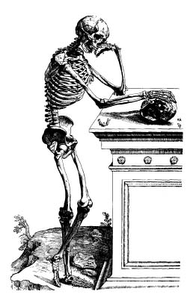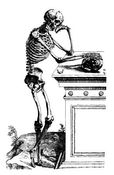Information
- Publication Type: Master Thesis
- Workgroup(s)/Project(s):
- Date: November 2006
- TU Wien Library:
- First Supervisor:
Abstract
The evolution of drawing reaches back to the origin of human cultural history.
Over 20.000 years ago prehistoric men started to picture their environment
in petroglyphs. From these caveman paintings to mythological depictions
of the ancient Egyptians, from medieval illuminated manuscripts
to Leonardo Da Vinci’s anatomical studies in the Renaissance, drawings
served the purpose of transforming information into a visually perceptible
form. Maybe it is this historical tradition that gives drawings the character
of being perceived as beautiful by a widespread public. Maybe it is the abstract
nature of drawings that lets them be an art form commonly chosen
for illustration. Often the first type of imagery we deal with in our lifetime
are hand-drawn images in children’s books. So we literally grow up with
drawings as a familiar medium for depiction. This could also be a cause
for the high acceptance drawings usually meet.
Drawings are commonly used in a scientific and educational context to convey
complex information in a comprehensible and effective manner. Illustration
demands abstraction for focusing attention on important features by
avoiding irrelevant detail. Abstraction is a characteristic inherent in drawing,
as a drawing always abstracts real world. Therefore drawings serve
the purpose of illustration very well. In addition to that, the expressiveness
and attraction of drawings bestow them the property of communicating information
in a way mostly felt as enjoyable.
Specific applications of volume visualization require exactly these visual
properties. Therefore increasing effort has been spent on developing and
applying illustrative or non-photorealistic rendering methods for volume
visualization in recent years. This is the field of study this thesis is devoted
to. The described capabilities of drawing make it the art form we
chose to mimic for the non-photorealistic volume rendering approach developed
in this thesis. A common shading technique in drawings is hatching.
Hatching is also standard practice in schematic hand-drawn illustrations
as known from textbooks. We implemented a system capable of generating
hatching drawings from volume datasets. The basic idea was to
exploit illustrative and aesthetic excellence of hatching drawings for the
creation of expressive representations of volumetric data.
The drawing in Figure 1 gives an example of an illustration where hatching
has been used for shading. This figure shall demonstrate that hatching is
a technique capable of conveying spatial properties of the depicted object
in an abstract and expressive way. It is an artwork of Vesalius’ De humani
corporis fabrica, a textbook of human anatomy from the Renaissance.
We propose some possible fields of application to further explain the motivation
to engage in generating hatching drawings from three-dimensional
data. The majority of these data are generated in medical scanning devices,
and medicine offers numerous possibilities for employing volume
hatching. One possible medical application would be to illustrate upcoming
surgeries to patients. Explaining a surgery with the help of a volume
hatching rendering is perhaps more comprehensible for a layman than with
tomography slices. It also could be more readily accepted by patients as a
realistic rendering, due to the visually pleasing nature of hand drawings
and the distaste of some people on viewing inner body parts realistically.
Another potential field of application for volume hatching is the automated
generation of educational illustrations. Figures in scientific textbooks, for
instance in medicine or botany, which shall convey important structural
features by a schematic representation of objects, are often drawn by hand.
The preferred drawing medium here is pen-and-ink, and a reduced drawing
technique is used where shading is realized with a sparse and even
hatching. Volume hatching can be employed for creating images resembling
such illustrations from volumetric data. On the one hand, this offers
the possibility for automated generation of still images for text- or schoolbooks.
On the other hand, interactive illustrations could be applied in
teaching, since they provide exploration and examining possibilities while
depicting the objects in a familiar illustrative style.
This thesis is organized as follows. First, we give an overview about research
done in fields related to this thesis in Chapter 2. In Chapter 3 we
present the algorithms we developed for rendering hatching drawings from
volume data. This includes the creation of contour drawings, curvature
estimation and generation of hatching strokes. We continue with shortly
outlining the concept of implementing these algorithms in Chapter 4. In
Chapter 5 we present and discuss result images, revealing advantages and
limitations of our approach. We summarize the content of this thesis in
Chapter 6. Finally, we draw a conclusion on the results of this thesis and
propose ideas for further enhancing our work in Chapter 7.
Additional Files and Images
Additional images and videos
Additional files
Weblinks
No further information available.
BibTeX
@mastersthesis{gerl-2006-vhi,
title = "Volume Hatching for Illustrative Visualization",
author = "Moritz Gerl",
year = "2006",
abstract = "The evolution of drawing reaches back to the origin of human
cultural history. Over 20.000 years ago prehistoric men
started to picture their environment in petroglyphs. From
these caveman paintings to mythological depictions of the
ancient Egyptians, from medieval illuminated manuscripts to
Leonardo Da Vinci’s anatomical studies in the Renaissance,
drawings served the purpose of transforming information into
a visually perceptible form. Maybe it is this historical
tradition that gives drawings the character of being
perceived as beautiful by a widespread public. Maybe it is
the abstract nature of drawings that lets them be an art
form commonly chosen for illustration. Often the first type
of imagery we deal with in our lifetime are hand-drawn
images in children’s books. So we literally grow up with
drawings as a familiar medium for depiction. This could also
be a cause for the high acceptance drawings usually meet.
Drawings are commonly used in a scientific and educational
context to convey complex information in a comprehensible
and effective manner. Illustration demands abstraction for
focusing attention on important features by avoiding
irrelevant detail. Abstraction is a characteristic inherent
in drawing, as a drawing always abstracts real world.
Therefore drawings serve the purpose of illustration very
well. In addition to that, the expressiveness and attraction
of drawings bestow them the property of communicating
information in a way mostly felt as enjoyable. Specific
applications of volume visualization require exactly these
visual properties. Therefore increasing effort has been
spent on developing and applying illustrative or
non-photorealistic rendering methods for volume
visualization in recent years. This is the field of study
this thesis is devoted to. The described capabilities of
drawing make it the art form we chose to mimic for the
non-photorealistic volume rendering approach developed in
this thesis. A common shading technique in drawings is
hatching. Hatching is also standard practice in schematic
hand-drawn illustrations as known from textbooks. We
implemented a system capable of generating hatching drawings
from volume datasets. The basic idea was to exploit
illustrative and aesthetic excellence of hatching drawings
for the creation of expressive representations of volumetric
data. The drawing in Figure 1 gives an example of an
illustration where hatching has been used for shading. This
figure shall demonstrate that hatching is a technique
capable of conveying spatial properties of the depicted
object in an abstract and expressive way. It is an artwork
of Vesalius’ De humani corporis fabrica, a textbook of
human anatomy from the Renaissance. We propose some possible
fields of application to further explain the motivation to
engage in generating hatching drawings from
three-dimensional data. The majority of these data are
generated in medical scanning devices, and medicine offers
numerous possibilities for employing volume hatching. One
possible medical application would be to illustrate upcoming
surgeries to patients. Explaining a surgery with the help of
a volume hatching rendering is perhaps more comprehensible
for a layman than with tomography slices. It also could be
more readily accepted by patients as a realistic rendering,
due to the visually pleasing nature of hand drawings and the
distaste of some people on viewing inner body parts
realistically. Another potential field of application for
volume hatching is the automated generation of educational
illustrations. Figures in scientific textbooks, for instance
in medicine or botany, which shall convey important
structural features by a schematic representation of
objects, are often drawn by hand. The preferred drawing
medium here is pen-and-ink, and a reduced drawing technique
is used where shading is realized with a sparse and even
hatching. Volume hatching can be employed for creating
images resembling such illustrations from volumetric data.
On the one hand, this offers the possibility for automated
generation of still images for text- or schoolbooks. On the
other hand, interactive illustrations could be applied in
teaching, since they provide exploration and examining
possibilities while depicting the objects in a familiar
illustrative style. This thesis is organized as follows.
First, we give an overview about research done in fields
related to this thesis in Chapter 2. In Chapter 3 we present
the algorithms we developed for rendering hatching drawings
from volume data. This includes the creation of contour
drawings, curvature estimation and generation of hatching
strokes. We continue with shortly outlining the concept of
implementing these algorithms in Chapter 4. In Chapter 5 we
present and discuss result images, revealing advantages and
limitations of our approach. We summarize the content of
this thesis in Chapter 6. Finally, we draw a conclusion on
the results of this thesis and propose ideas for further
enhancing our work in Chapter 7.",
month = nov,
address = "Favoritenstrasse 9-11/E193-02, A-1040 Vienna, Austria",
school = "Institute of Computer Graphics and Algorithms, Vienna
University of Technology ",
URL = "https://www.cg.tuwien.ac.at/research/publications/2006/gerl-2006-vhi/",
}

 pdf
pdf

